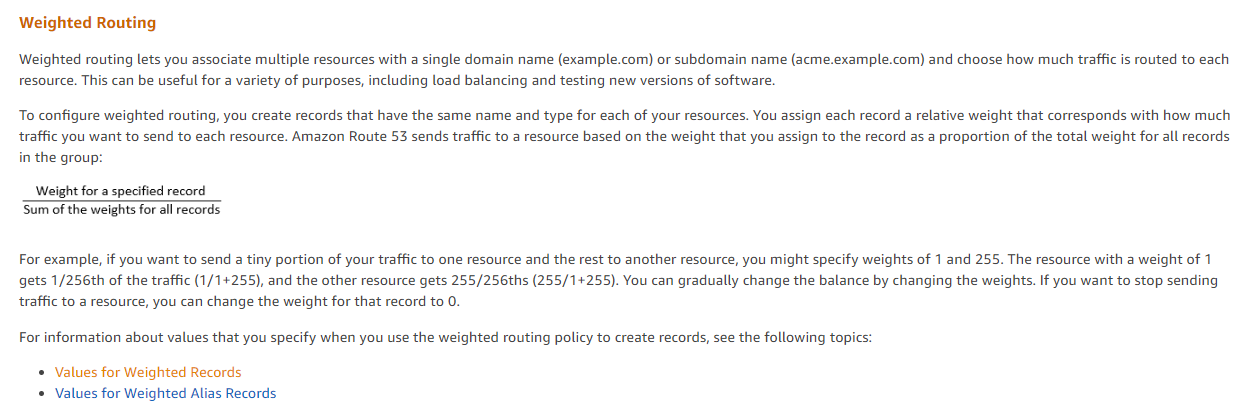How to Configure Route 53 Record Sets for Load Balancer Traffic Distribution
Question
You are planning to launch a web based application in two different regions within US on AWS due to your organization compliance policies.
You have setup 2 EC2 instances attached to an elastic load balancer in us-east-1
You have replicated the same setup in us-west-1
Now you have two load balancers which needs to listen traffic from internet.
You would want to split the requests equally between both load balancers from a domain name hosted on your AWS Route 53
How should you configure your Route 53 record sets?
Answers
Explanations
Click on the arrows to vote for the correct answer
A. B. C. D.Answer: B.
https://docs.aws.amazon.com/Route53/latest/DeveloperGuide/routing-policy.html#routing-policy-weighted.
Option A is not correct.
According to above screen shot, with weights 1 and 2, the request distribution is 1:2 which is not equal.
Option B is correct as the distribution ratio would be 1:1
https://docs.aws.amazon.com/Route53/latest/DeveloperGuide/TutorialManagingOver100WRR.htmlOptions C and D are not correct.
A record set can only have one Alias Target.
https://docs.aws.amazon.com/Route53/latest/DeveloperGuide/resource-record-sets-values-alias.html#rrsets-values-alias-alias-target
Sure, I can provide a detailed explanation of the answer options for this question.
Scenario: The scenario involves launching a web-based application in two different regions within the US on AWS. Two EC2 instances have been set up in us-east-1 and us-west-1, respectively, and both are attached to an Elastic Load Balancer. Two load balancers have been replicated to cater to each region.
Requirement: The requirement is to split the requests equally between both load balancers from a domain name hosted on AWS Route 53.
Answer Option A: This answer option suggests creating two record sets, one for each load balancer in us-east-1 and us-west-1. The weighted routing policy would be set with weights as 1 and 2, respectively.
Explanation: Weighted routing policy is used to distribute traffic across multiple resources in proportion to their assigned weights. In this case, the weight assigned to the us-west-1 load balancer is higher than the us-east-1 load balancer. As a result, the traffic distribution would not be equal, and the requirement of splitting requests equally would not be met. Hence, this answer option is incorrect.
Answer Option B: This answer option suggests creating two record sets, one for each load balancer in us-east-1 and us-west-1. The weighted routing policy would be set with weights as 1 and 1, respectively.
Explanation: This option satisfies the requirement of splitting requests equally between both load balancers. By setting the weights as 1 and 1, the Route 53 service would distribute the traffic equally between both load balancers, ensuring that the requests are split equally. Therefore, this answer option is correct.
Answer Option C: This answer option suggests creating a single record set and selecting both load balancers as Alias Targets. The weighted routing policy would be set with weights as 1 and 2, respectively.
Explanation: This option is incorrect as the weighted routing policy is not required to achieve the requirement of splitting requests equally between both load balancers. Moreover, selecting both load balancers as Alias Targets with different weights will result in an unequal distribution of traffic, which does not meet the requirement. Therefore, this answer option is incorrect.
Answer Option D: This answer option suggests creating a single record set and selecting both load balancers as Alias Targets. The weighted routing policy would be set with weights as 1 and 1, respectively.
Explanation: This option is the same as Option B, which satisfies the requirement of splitting requests equally between both load balancers. By setting the weights as 1 and 1, the Route 53 service would distribute the traffic equally between both load balancers, ensuring that the requests are split equally. Therefore, this answer option is correct.
In summary, the correct answer to this question is B. Create two record sets, one each for us-east-1 and us-west-1 load balancers. Set weighted routing policy with weights as 1 and 1, respectively.
